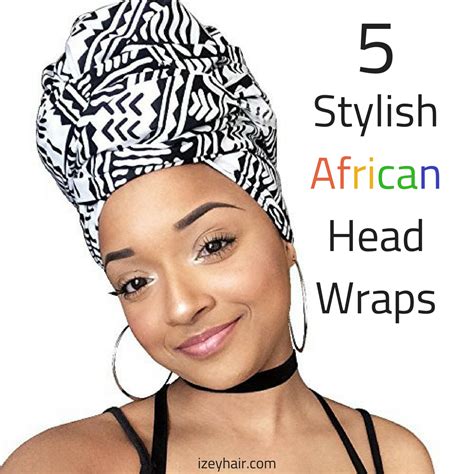African head wraps, an integral part of many African cultures, continue to captivate with their vibrant colors, intricate designs, and endless versatility. From traditional ceremonies to contemporary fashion, these head coverings elevate any ensemble, showcasing the wearer’s creativity, cultural heritage, and personal style.

101 Styles of African Head Wraps
The diversity of African head wraps is astounding, with countless variations across regions and ethnic groups. Here are 101 popular styles to explore:
- Gele: A sophisticated headpiece typically made from aso oke fabric, characterized by elaborate pleating and adorned with beads or embroidery.
- Turbans: Wrapped in various forms, these head coverings provide fullness and volume, often embellished with intricate beadwork or metallic accents.
- Ipele: A Yoruba wrapper known for its distinctive tie-dye patterns, worn over the head in a graceful manner.
- Duku: A loose, flowing head wrap common among Fulani women, decorated with beads and shells.
- Sheda: A traditional Ethiopian scarf worn over the head and shoulders, often featuring vibrant colors and patterns.
- Gele Oleku: A stylish gele style with a knotted top, reminiscent of a butterfly’s wings.
- Aso Oke Gele: A stunning headpiece made from handwoven aso oke fabric, showcasing the vibrant threads and intricate patterns.
- Auto Gele: A ready-to-wear gele with pre-tied knots, offering convenience and a polished look.
- Gele with Beads: Gele adorned with an array of beads, adding shimmer and elegance to the headpiece.
- Irun Kiko: A practical head wrap made from cotton or kente cloth, often used for everyday wear.
- Iro and Buba: A traditional Yoruba ensemble that includes a head wrap, wrapper, and blouse, typically featuring matching patterns.
- Geles with Jewelry: Gele adorned with jewelry, such as earrings, brooches, or necklaces, adding a touch of glamour.
- Damask Gele: A luxurious headpiece made from damask fabric, known for its intricate designs and rich colors.
- Headband: A simple yet stylish head covering, often made from fabric or leather, adding a touch of sophistication.
- Scarf: A versatile and adjustable head covering, available in a wide range of colors and patterns.
- Bandana: A square or triangular fabric used to cover the head, often featuring bold colors and prints.
- Veil: A sheer or opaque fabric used to cover the face or head, providing modesty or protection.
- Crown: A decorative head covering resembling a crown, often adorned with jewels or beads.
- Fascinator: A small, elaborate headpiece that adds a touch of whimsy or elegance.
- Tiara: A headband with a raised center, often encrusted with jewels or intricate designs.
Techniques for Tying African Head Wraps
Mastering the art of tying African head wraps requires practice and patience. Here are some common techniques:
- Basic Wrap: A simple technique that involves wrapping the fabric around the head and securing it with a knot.
- Double Wrap: A variation of the basic wrap, where the fabric is wrapped twice around the head for added fullness.
- Turban Technique: A technique that involves wrapping the fabric into a turban shape, providing volume and fullness.
- Knotted Wrap: A technique that involves tying the fabric in multiple knots, creating a decorative effect.
- Pleated Wrap: A technique that involves pleating the fabric before wrapping it around the head.
- Crossover Wrap: A technique that involves crossing the fabric over the head, creating an eye-catching design.
- Bun Wrap: A technique that involves wrapping the fabric around a bun or chignon.
- Layered Wrap: A technique that involves layering multiple fabrics or wraps for added texture and visual interest.
- Asymmetrical Wrap: A technique that involves tying the fabric in an asymmetrical manner, creating a unique and edgy look.
- Off-Center Wrap: A technique that involves placing the fabric slightly off-center on the head, adding a touch of sophistication.
Benefits of African Head Wraps
Beyond their aesthetic appeal, African head wraps offer numerous benefits:
- Cultural Significance: Head wraps play a significant role in African cultures, representing identity, status, and tradition.
- Sun Protection: Fabric head wraps provide protection from the sun’s rays, shielding the scalp from sunburn and UV damage.
- Hair Protection: Head wraps help protect natural hair from breakage, tangles, and dryness.
- **Access
